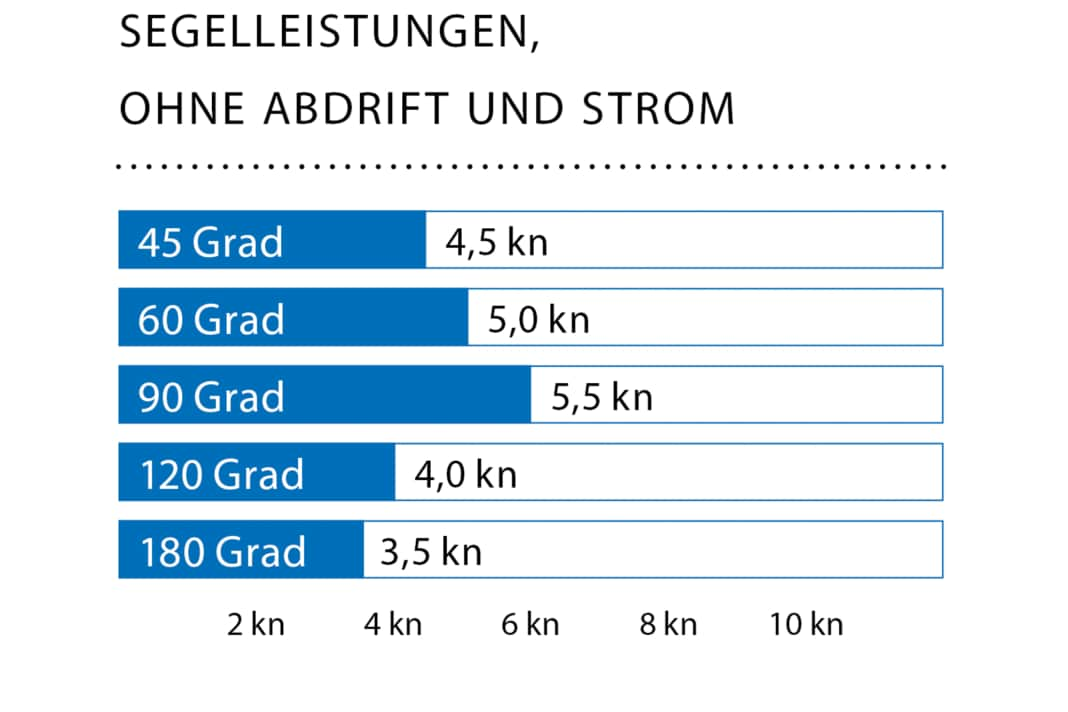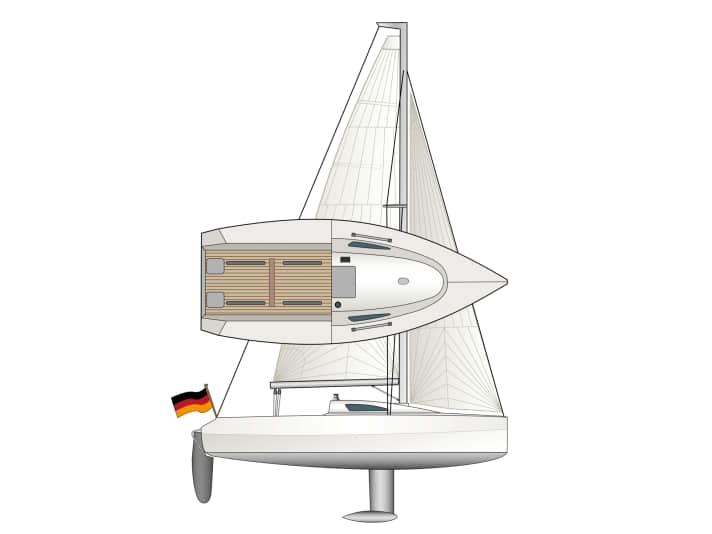





The XP-19 steers agilely across the Dümmer in Lower Saxony. Despite the light breeze, the six-metre-long boat gets off to a good start, every little gust provides noticeable acceleration, then the log rises effortlessly to 5 knots.
Andreas Budde is visibly satisfied. The new boat was his idea and was created under his leadership. Microtonn sailor Budde wanted a boat for fast after-work sailing that was a little more modern than the regatta micros built according to strict design rules. So, together with a friend who was familiar with CAD software, he designed a hull with distinctive chines, a steep stem and a slightly longer hull length than a Microtonner.
Also interesting:
The prototype was built in moulding construction over Mallen, but was not completed at the shipyard in Gdansk. Budde then shipped the hull to the shipyard in Serbia, which had also built his previous Microtonner. Here the hull was completed and the deck of Budde's last Micro was copied without further ado. The mould was still in the corner, and the entrepreneur appreciated the spacious cockpit anyway.
The prototype was ultimately used to approve the mould in which the test boat, construction number 1 of the XP-19, was then built. The hull was produced as a polyester full laminate, the deck is designed as a sandwich with a foam core and an inner shell in the area of the superstructure and the side decks. The construction quality of the GRP parts is very good. The deck-hull joint is almost invisible; it is formed with an adapter piece that starts ten centimetres below the upper edge of the hull and extends to the foot rail; it is fully laminated. The connection can only be recognised as a slight unevenness when viewed against the light, so it is also noticeable that the chines are not completely clean.
However, these are not flaws that immediately catch the eye, nor do they in any way diminish the sailing pleasure. And that is definitely high with the XP-19.
Measured values of the XP-19




The XP 19 is now laminated in Poland. From build number seven, the interior is also moulded from one GRP part. This saves time during construction, but does not change the weight. XP is short for Express and stands for speed. Budde realised that this abbreviation is also used by X-Yachts in time to reach an agreement with the Danes: They don't see a problem, especially as they don't have a yacht of the same size in their programme.
The XP-19 is designed for single-handed sporty daysailing. All trimming devices are within reach of the steering position. This is also very variable thanks to a length-adjustable tiller arm from Osculati. However, the cockpit offers enough space for two or three sailors. At the tiller, the boat behaves like a large dinghy, it steers very directly and starts immediately in gusts. However, the rudder lock, a rubber band, still needs to be improved, as the rudder blade could fold slightly aft when travelling faster through the water, which increased the rudder pressure considerably.
The sails were easy to trim, with the exception of an annoying diagonal crease from the clew to the centre of the luff. Either the sailmaker made a mistake here, or the attachment of the sail neck needs to be optimised. It was tied down, but there was no way to tighten the luff downwards, for example with a cunningham.
A lightweight under sail
The agile sailing behaviour is certainly partly due to the low weight in relation to the relatively large sail area. The ballast is also quite low. However, the boat does not make a particularly lanky impression at a maximum of 3 Beaufort. It does heel in gusts without weight on the edge, but it stabilises again with the chines in the water at the latest. Nevertheless, the outhaul straps are very useful, they also enhance the dinghy feeling. And the small amount of ballast is compensated for by two people on the edge. It would be nice to have an elastic band or a batten to hold the straps open so that you could simply slip into them.
The high sail carrying capacity of over 5 emphasises the potential of the XP-19, but is also partly misleading for such a small boat. As this value is calculated from the boat's weight and sail area, it inevitably decreases as the payload increases. With a displacement of 650 kilograms, two people carrying 80 kilograms each is an enormous payload. The XP-19 also becomes noticeably faster when Andreas Budde switches to the photo boat and the single-handed capability is examined more closely.
After an extended cross with plenty of wind shifts, which can be steered very intuitively, we set off on a rough course. Now a gennaker would be nice - surprising that Budde, who designed a sporty daysailer, did not include one.
However, the idea fell on fertile ground with him, so that he calculated the costs with the shipyard just a few days after the test. A retractable gennaker pole, deflections and additional clamps for sheets and halyard totalled 1400 euros. Then there is the gennaker itself. If the boat is sailed by two people, this is certainly a must, but it is also a nice addition on its own.
Below deck
In the standard version, the cabin is a storage area for the sails and a place to retreat to during rain showers; it was not primarily designed as a living space. Apart from storage compartments for equipment, it also offers no comfort such as a pantry or toilet, not even cushions are provided. However, these and a cooking box are available as options, making the XP-19 suitable for touring - with reduced comfort. The forward berth, for example, is only long enough if the head is placed on the saloon berth. And the saloon berths are too narrow at 48 centimetres wide.
Prices of the XP-19
Extrabyte, the name of Budde's company, offers a ready-to-sail boat for 29,600 euros, but without an outboard motor and trailer.
- Base price ex shipyard: 29.600 €
- Guarantee/against osmosis: 2/2 years
Status 2025, how the prices shown are defined, read here!
Included as standard are all fittings, a rig from Sailart (the same as on the Sailart 18), two mainsails (one for strong winds), headsail with furling system from Bartels, a removable mast bracket for laying, two bags and outhaul straps. Construction number 7 is currently being built. Since this year, construction has been taking place in Poland. The interior now consists of a single GRP element, without this affecting the weight. As an option, the hull can be built using the vacuum infusion process, which costs around 30 per cent more but makes the boat somewhat lighter.
YACHT rating of the XP-19
The XP-19 is a sporty daysailer for one to two people on inland and coastal waters. The designer also realises special requests such as a deeper keel.
Design and concept
Daysailer for one or two sailors
Lifting keel facilitates trailering
Large cockpit
Sailing performance and trim
Sails agile and fast
Weight required on the edge in windy conditions
No gennaker provided as standard
The XP-19 in detail

Technical data of the XP-19
- Design engineer: Andreas Budde
- Torso length: 6,00 m
- Width: 2,44 m
- Draught (lifting keel): 0,35-1,25 m
- Weight: 0,65 t
- Ballast/proportion: 90 kg/14 %
- Mainsail: 11,5 m²
- Mainsail 2: 6,5 m²
- Furling genoa (105 %): 8,0 m²
- machine (Torqeedo): 2.2 kW/3 hp
Hull and deck construction
The fuselage is a polyester full laminate. As an option, the hull can be built using the vacuum infusion process. The deck is made of sandwich laminate with a foam core.
Shipyard and distribution
Germanboats, Klopstockstraße 8, 33613 Bielefeld; www.xp-19.com
The test was first published in 2020 and has been updated for this online version.

